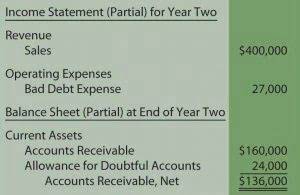Content

This is in contrast with bad debt expense, which is a way of anticipating future losses. For a totally worthless debt, you need to file by either seven years from the original return due date or two years from when you paid the tax, whichever is later. In some cases, it may be smart to hire a debt collection agency to collect outstanding customer payments. Although you’ll need to spend money in order to hire a debt collector, you may find that customers are more likely to pay their invoices after hearing from a collections agency. When a family owes money you are unable to collect, you’ll eventually want to zero out the balance on the Family Ledger Card.
- I am a Certified Payroll Professional and Advanced Certified QuickBooks ProAdvisor, providing payroll and accounting services to businesses.
- Fortunately for you, it’s simple to keep track of personal loan matters.
- For a business that provides a service or sells goods on credit, bad debts might be inevitable.
- You can prove your loan recipient can’t pay you back by showing bank statements or bankruptcy filings .
- In this method, the seller charges the original unpaid invoice amount to their allowance for doubtful accounts.
Based on this precedent, a business may reasonably create a bad debt provision for 5 percent of current accounts receivable. Nonbusiness bad debts must be totally worthless to be deductible. If you use the cash-based method ofaccounting, it may feel as though you’re getting short changed. In reality, no one wins when unpaid invoices become worthless. If you’re eligible to write off the unpaid invoice, it’s because you would’ve had to pay taxes on income that didn’t exist. After all, unpaid invoices can wreak havoc on your business finances.
Writing Off Bad Debt In Accounts Receivable
After confirming this information, Gem concludes that it should remove, or write off, the customer’s account balance of $1,400. The purpose of the matching principle is to have businesses report the full scope of revenue-generating transactions during the same accounting period. For instance, a business owner may decide to loan money to a client who is expanding their business in a way that will financially benefit both parties.

With accrual based accounting, on the other hand, you would have counted income when you earned it. However, once you determine that you’re not getting paid for that invoice, you need to write it off as a bad debt expense. If you use cash-method accounting, you generally can’t write off unpaid invoices because when you use the cash method of accounting, you only count revenue when you receive it. With an unpaid invoice, you never receive revenue, so you have no revenue from which to write off the unpaid invoice. Credit the asset account where the bad debt is recorded by the same amount. This distortion goes against GAAP principles as the balance sheet will report more revenue than was generated. This is why GAAP doesn’t allow the direct write off method for financial reporting.
The Debt Must Be Worthless
The general rule is to write off a bad debt when you’re unable to contact the client, they haven’t shown any willingness to set up a payment plan, and the debt has been unpaid for more than 90 days. Units should consider using an allowance for doubtful accounts when they are regularly providing goods or services “on credit” and have experience with the collectability of those accounts. The following entry should be done in accordance with your revenue and reporting cycles , but at a minimum, annually. It’s an effective safeguard against bad debt and provides confidence to trade. If bad debt relief is paid, your company adjusts by reducing the VAT on purchases for the period in which the debt relief payment is received. If your company receives payment of a part of the debt, an adjustment for the bad debt relief already claimed must be made.
- For example, if your company’s average DSO is 75 days, you might decide that after an additional 90 or 120 days, the debt should be sent to collections and written off.
- A debit entry for the same amount is entered into the “Allowance for Doubtful Accounts” column to balance the balance sheet.
- The direct write off method is one of two methods to account for bad debts in bookkeeping.
- Good practice is to add an account to the Expenses category of your chart of accounts, naming it something like Bad debts.
He is the sole author of all the materials on AccountingCoach.com. The offers that appear in this table are from partnerships from which Investopedia receives compensation. Investopedia does not include all https://www.bookstime.com/ offers available in the marketplace. Under GAAP, banks are usually required to keep reserves for bad loans. When a business does not expect to recover a debt, the debt becomes bad and is written off.
Writeoff A Customer Bad Debt
Rather than 165 or 195 days, as in the above example, the company may settle on 150 days in order to limit the carrying expense. To keep DSO from being skewed, bad debt might be written off after a certain number of days.
Before taking any of these steps, however, it’s important to make attempts to collect the debt and document all of your efforts. An example of a nonbusiness debt is if you loan money from your personal bank account to a friend, who promises in writing to repay you. If that friend files for bankruptcy and can no longer reasonably pay you back, you now have a bad debt. For many business owners, it’s possible to get a bad debt deduction on their taxes to help regain some of what was lost.
The Direct Write Off Method
Once a company’s internal collection policy has run its course, the next step is usually hiring a collection agency. For detailed expectations and guidelines related to write offs, see Writing Off Uncollectable Receivables. An employee-related write-off may result in taxable income to the employee. Payroll should be notified of all employee-related write-offs. Harold Averkamp has worked as a university accounting instructor, accountant, and consultant for more than 25 years.

The amount that is written off depends on the percentage of bad debt you believe your company incurs throughout the year. Normally, you would make a General Journal entry affecting an accounts receivable (used as a contra-asset) account titled “Allowance for Doubtful Accounts” and Bad Debt Expense . Then, each invoice is written off to Allowance for Doubtful Accounts as the bad debt is recognized. The average American held $16,458 in personal loan debt in 2020. One way to tame your frustration is to write off bad debt for unpaid personal loans you might have doled out throughout the year. Your customer must reverse the input tax related to the defaulted payment as output tax and the relevant tax amount must be paid back to the tax authorities. This is applicable when you have already accounted for VAT but your customer defaults on full or partial payment.
What Are The Irs Rules Of Writing Off Notes Receivable?
Additionally, a guarantor is allowed a business bad debt deduction for any payment made in the capacity as guarantor if the reason for guaranteeing the debt was business. Here, How to Write Off Bad Debt the guarantor’s payment results in a loan to the debtor, and the taxpayer is allowed a bad debt deduction once the loan becomes partially or totally worthless (Regs. Sec. 1.
![]()
It could also be that you’ve extended credit to an unsuitable customer. If this is the case, you should tighten up your credit control policyto prevent it from happening in the future. We now offer 10 Certificates of Achievement for Introductory Accounting and Bookkeeping. Full BioMichael Boyle is an experienced financial professional with more than 10 years working with financial planning, derivatives, equities, fixed income, project management, and analytics. We’re transparent about how we are able to bring quality content, competitive rates, and useful tools to you by explaining how we make money. Our experts have been helping you master your money for over four decades. We continually strive to provide consumers with the expert advice and tools needed to succeed throughout life’s financial journey.
Recovery Of Account Under Allowance Method
In addition, losses can’t be claimed for partially worthless non-business bad debts. In accrual-basis accounting, recording the allowance for doubtful accounts at the same time as the sale improves the accuracy of financial reports. The projected bad debt expense is properly matched against the related sale, thereby providing a more accurate view of revenue and expenses for a specific period of time. In addition, this accounting process prevents the large swings in operating results when uncollectible accounts are written off directly as bad debt expenses.
When Should A Business Write Off A Bad Debt?
These insights are valuable components of understanding what is bad debt, of helping you make better-informed decisions and of creating a successful business strategy. The bad debt letter should be succinct, written on your company letterhead, include your signature, and suggest how to resolve the matter in a timely fashion. Learn more by reading our article on how to collect late payments, that includes tips to write bad debt letters. A bad debt provision or allowance is an accounting method that requires you to estimate the amount of bad debt that you expect to write off in any given period. In the U.S., the direct write-off method is required for income tax purposes, but is not the method to be used for a company’s financial statements. A write-off primarily refers to a business accounting expense reported to account for unreceived payments or losses on assets.
This amount is a debit to the allowance for doubtful accounts and a credit to the accounts receivable account. In this method, the seller charges the original unpaid invoice amount to their allowance for doubtful accounts.
“Assuming that you can deduct a debt in a specific year, it may make sense to delay or accelerate bad debt deductions as part of your overall tax planning strategy,” says Brim. For example, you may not feel ready to deem a debt “completely worthless” until you’ve waited long enough that you’re absolutely certain you’ll never be repaid. In the direct write off method, there is no contra asset account . As a result, everything in the Account Receivable book will be counted as a current asset on the company or individual’s balance sheet.
How Student Loans Impact Your Taxes
You can’t always control bad debts, but you can work toward making sure they happen less frequently by pursuing payment. Offering customers goods and services on credit is a great way to make big sales, but it could end up costing you if the customer never pays. You could decide not to offer credit, or you could learn what to do when a customer won’t pay you. For a partly worthless debt, file your claim by three years after filing the original return or two years from when you paid the tax, whichever is later. When money owed to you becomes a bad debt, you need to write it off.
Is it too late to take a bad debt deduction on your tax return? If you just realized you can get nonbusiness bad debts written off on your taxable income, know that you usually only have three years to amend a tax return 🤯. Check which tax year the loan became worthless to see if you can still claim a write-off for it.
